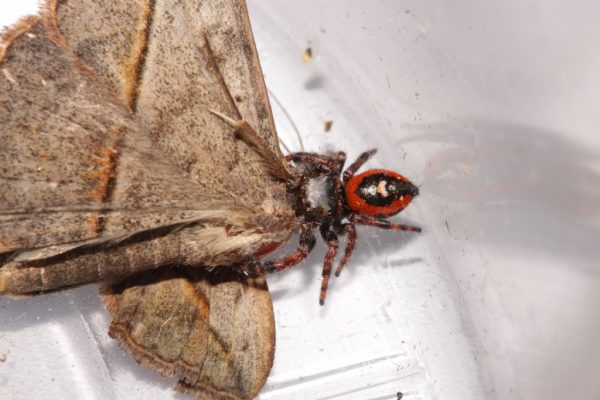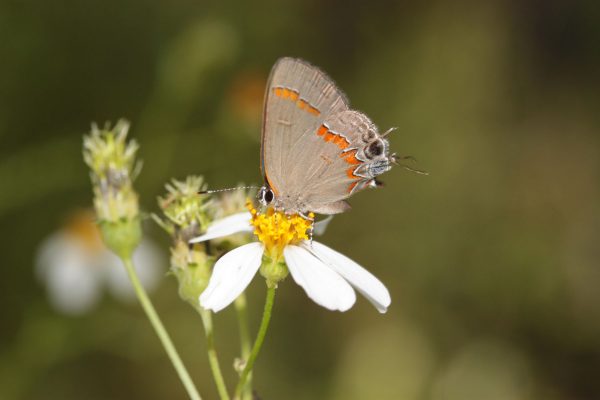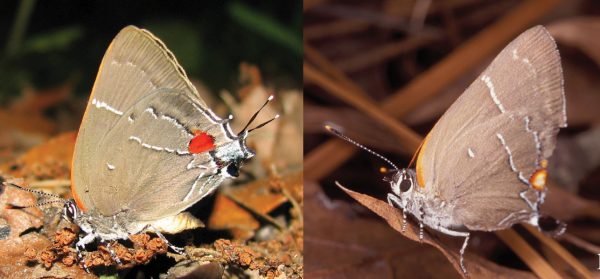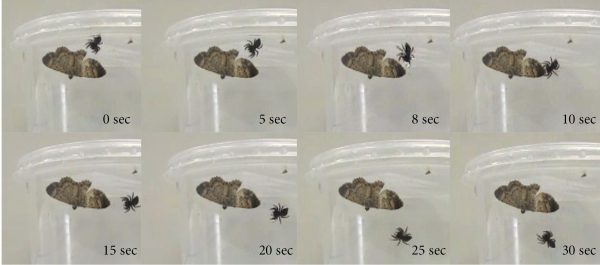
Florida Museum photo by Andrei Sourakov
Butterflies are among the most vibrant flying insects, with colorful wing patterns sometimes designed to deflect predators. From frogs and lizards to birds and spiders, butterflies have scores of enemies, so thousands of Lepidoptera species have evolved to imitate leaves, eyes, beaks or other insects.
When biologists first started asking questions about butterfly evolution, they looked to the vertebrates for answers. Birds and lizards are known to hunt butterflies, and for the last 150 years, researchers have assumed these vertebrate predators were driving the evolution of wing patterns. New Florida Museum of Natural History research shows that in the case of hairstreak butterflies, evolution may be driven by a much smaller enemy: the jumping spider.
“I think it’s a big step in general and a big leap of faith to realize that a creature as tiny as a jumping spider, whose brain and life span are really small compared to birds, can be partially responsible for the great diversity of patterns that evolved out there among Lepidoptera and other insects,” said Andrei Sourakov, collection manager at the McGuire Center for Lepidoptera and Biodiversity. “These seemingly primitive creatures have a very complex way of hunting, memory, conditioning and problem-solving intelligence.”

Florida Museum photo by Andrei Sourakov
In the behavioral study published online March 8, 2013, in the Journal of Natural History, Sourakov conducted the first direct test of the defense mechanism of hairstreak butterflies. When the hairstreak butterfly faced the jumping spider in an enclosed space, the butterfly successfully escaped 100 percent of the time. The study shows jumping spiders may have influenced evolution of some butterfly patterns and behaviors.
“Everything we observe out there has been blamed on birds: aposematic coloration, mimicry and various defensive patterns like eyespots,” Sourakov said. “Recently, more information became available about how good the vision of jumping spiders is and how smart they are as hunters, but little is known about their influence on Lepidoptera evolution.”
Sourakov’s experiments showed the Red-banded Hairstreak butterfly, Calycopis cecrops, whose spots and tails imitate a false head, successfully escaped all 16 attacks from the jumping spider, Phidippus pulcherrimus. When 11 other butterfly and moth species from seven different families were exposed to the jumping spider, they were unable to escape attack in every case. Sourakov collected data by analyzing the videotaped results in slow motion.
“When I saw the spider behind the museum and then saw the hairstreak flying around, I started testing how that spider would hunt different Lepidoptera prey,” Sourakov said. “I had a spider living on my desk for a long time, and I had a camera next to me, so as I was working on other projects, I had the camera recording their behavior.”
“From the video, you can see the spider is always very precise,” Sourakov said. “In a series of frames grabbed from the video, one can observe how the spider walks very carefully around a moth that looks like a leaf, identifies the head, and then attacks at the head region. The spider has an innate or acquired ability to distinguish the head region very well and it always attacks there to deliver its venom to the vital center to instantly paralyze the prey. Most importantly, the spider is very small, so sometimes its prey is 10 times larger.”

Florida Museum photo by Andrei Sourakov
The species of hairstreak butterfly and jumping spider used in the experiment are both common in the southeastern U.S., with similar relatives spread worldwide. In nature, the spider and hairstreak come into contact when the butterfly lands on leaves or flowers to rest and feed. Female Red-banded Hairstreak butterflies lay their eggs in leaf litters, which are often crawling with spiders.
David Wagner, a professor of ecology and evolutionary biology at the University of Connecticut who was not involved with the study, said the research shows scientists need to rethink what drives adaptive coloration patterns because the results suggest “birds are only part of the story.”
“I thought it was a fantastic example of the adaptive colorations that we find in animals, and so many of these we attribute to birds and vertebrates in terms of being sort of the smart predators that drive some of these wonderful patterns in nature, such as the tails and eye spots on butterflies,” Wagner said. “Andrei’s study clearly makes us rethink that – invertebrates, in particular spiders and jumping spiders, may be really important drivers in shaping what the world looks like.”
Are two heads better than one?
Unlike other butterflies, hairstreaks frequently move the hind wings that carry the false head pattern, a behavior that seems to increase in the presence of the spider, as if the butterfly is attracting attention to itself, Sourakov said. As early as 1922, Victor Gurner Logan Van Someren showed that lizards often attack this region, which allows the hairstreak to escape.

Florida Museum photo by Andrei Sourakov
In museum collections, hairstreak specimens are frequently found with the false-head portion of the wings missing, and in the 1980s, Bob Robbins at the Smithsonian Institution determined by analyzing hundreds of specimens that the more deceptive-looking the false head, the more frequently it is found damaged. This classic work has served as circumstantial evidence that the false-head region in hairstreaks is indeed important in deflecting the predators’ attacks, Sourakov said.
During Sourakov’s experiments, the spider always attacked the butterfly’s false head, thereby avoiding its vital organs. Although this evidence of the role of spiders in the evolution of the false head pattern is novel, other research showing spiders may drive the evolution of Lepidoptera wing patterns and behaviors is represented in a detailed study by Wagner and Jadranka Rota, a researcher in the University of Connecticut department of ecology and evolutionary biology. Conducted in Costa Rica, their study shows a small metalmark moth can effectively deceive a jumping spider by mimicking the spider’s pattern and behavior.
“The false head hypothesis in hairstreaks has been in circulation for a long time because people always speculated that their tails move around in order to fake out the predators, but there was little experimental evidence and field observations are very scarce,” Sourakov said.
Sourakov said he hopes the study encourages behavioral ecologists to further test the idea that evolution in butterflies and moths may be driven by small invertebrate predators.
“This clearly shows it’s possible that many spectacular patterns and behaviors that we find in smaller insects may be due to spider pressure rather than bird pressure,” Sourakov said. “The butterfly escapes from the spider – it’s a fairytale story.”
To view the study and a video of the research, visit http://www.tandfonline.com/doi/full/10.1080/00222933.2012.759288.
Learn more about the McGuire Center for Lepidoptera & Biodiversity at the Florida Museum.